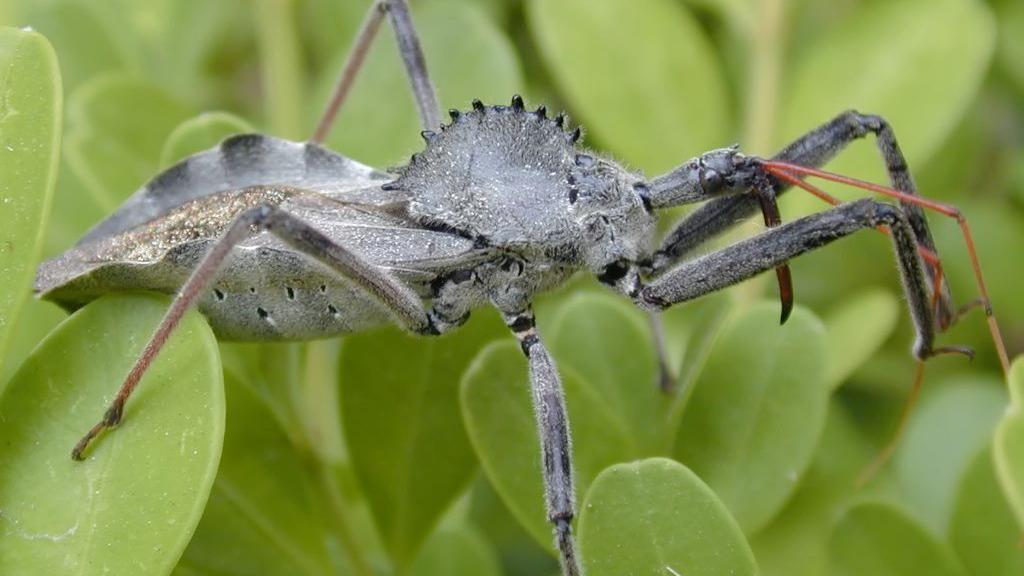YARD AND GARDEN: Discover the eerie wheel bug | Home & Garden

Master Gardener Darla Chouinard introduces us to the eerie wheel bug.
Recently, a neighbor posted a picture of a big scary bug on social media inquiring what it was. I promptly identified it as an assassin bug or a wheel bug specifically an Arilus cristatus (Linnaeus). I am familiar with the wheel bug, as I found a dead one at my house not long before. There are about 160 species of assassin bugs in North America but the cristatus variety is found only in the United States.
Even though these bugs are terrifying, they are beneficial to the farmer and gardener. Their diet includes “pest insects” including insect eggs, leafhoppers, aphids, larvae, moths, and caterpillars, just to name a few. It is also one of the few bugs that eat the brown marmorated stink bug. Unfortunately, they eat beneficial bugs like lady beetles and honey bees.
The adult wheel bug is approximately 1 to 1.25 inches long. Its coloring can be dark brown, grey, or black and they have a somewhat camouflaged appearance. It has a sturdy rigid body with long spooky spindly legs and antennae with a stout pointy beak.
They have large beady eyes on a slim head, and a prominent thoracic (the midsection on a bug body) with a semicircular crest that resembles a cogwheel or a half-circular saw blade that stands up on its back. The semicircle crest is present only on the cristatus species in the United States. The wheel bug gets its name from this semicircular crest.
Wheel bugs move and fly slowly and clumsy. While in flight, they sound like a grasshopper and make a loud buzzing sound. They stalk their prey or wait for them to cruise past, then quickly attack with their piercing beak. It then injects a toxic paralytic substance that instantly immobilizes, then kills its prey within 30 seconds of injection.
These insects should be avoided as they will easily inflict a painful bite on humans. It has been said that the bite feels as bad or worse than bees, hornets, and wasps. Initially, the bite is painful, followed by numbness for a few days. It becomes red and hot to touch and later may become white and hardened at the puncture. It usually takes two weeks to heal from a wheel bug bite. Therefore, it’s advisable to admire them and not handle them.
Wheel bugs lay their eggs on branches of trees and shrubs in late fall and the eggs resemble tiny brown bottles in a cluster. The eggs overwinter and hatch in spring. When they hatch the nymphs are bright yellow-orange. The nymphs or young have five stages to transition through before they molt into an adult. As they molt, their color changes too.
Even though these bugs are terrifying, they are few, and control measures are not recommended as they provide benefits to your garden by eating pests.
To learn more about these fascinating insects go to https://growingsmallfarms.ces.ncsu.edu
If you have questions about your garden or landscape, contact a master gardener at the University of Illinois Extension office in Mattoon at 217-345-7034 or through our online hotline at https://forms.illinois.edu/sec/1523725.
Be sure to visit U of I Extension’s horticulture website http://web.extension.illinois.edu/ccdms/ and like the Master Gardeners’ Facebook page www.facebook.com/ColesCountyMasterGardeners.
Mattoon-area places through the years
Young Radiator

1983: The Young Radiator plant was set to close due to a disputed union contract. Local 162 UAW and the company reached an agreement on a new three year contract at the last minute.
Oil well

1945: Baker’s No. 1 Bates well, a half-mile north of present production, waiting to drill plug, is creating tense speculation over possible field extension.
New post office

1981: The postmaster has given his stamp of approval on the new post office. One problem remaining is the different alignment of post boxes which has forced new numbers on 112 customers and left 65 more with boxes that are smaller than they are used to.
Memorial District Hospital

1956: Many residents are recalling events and personalities in the 50 history-making years of the hospital as the completion of the $1,150,000 expansion project is complete.
Mattoon Mounters

1985: Class 4 state champions at Mattoon Academy of Gymnastics and Dance include: front row, from left, Krista Budde, Michelle Cisna, Stacey Brown; second row, Christi Horein, Erica Vaultonburg, Jennifer Daily, Lori Shafer, Dixie Usinger, Toni Best, Jessica Kessler; back row, Tina Barnes, Nikki Shaw, Kim Jurgens, Pennie Lane, Elizabeth Ettlebrick, Angie Tilford, Christina Ritter, Johnna Von Behrens.
Kozy Log

1983: W.D. “Pill” Fisher stands by the log house h is building for his family. Fisher became distributor for Kozy Log homes.
Illinois Central Railroad depot

1977: The once bustling waiting room rests quietly except for an occasional passenger for one of the station’s four trains.
Downtown

1973: Mattoon earned a berth in the finals of the All-America Cities competition.
Downtown

1988: Mattoon was bustling in the 1950s, as this vintage photo shows. Photos are being compiled in a book by Alice Larrabee, Gail Lumpkin, Jean Johnston and Marianne Thiel.




